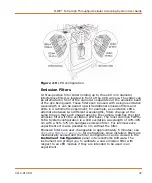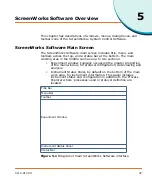
FLIPR
®
Tetra High Throughput Cellular Screening System User Guide
0112-0109 H
33
CCD Camera Options
Two camera options are available for purchase with the FLIPR
®
Tetra
System. A standard, EMCCD (Electron Multiplying CCD) camera is
recommended for fluorescence only experiments, while the more
sensitive Aequorin ICCD (Intensified CCD) camera is designed for both
fluorescence as well as luminescence assays.
Standard EMCCD Camera
The CCD camera is located directly beneath the read plate on the five-
position stage. The camera is thermoelectrically cooled and requires
about five minutes to reach its operating temperature of -60 ± 2 °C.
The camera uses frame-transfer technology that shifts pixel values
from the exposed portion of the chip to the data processing portion.
This method allows a high acquisition rate and eliminates the possibility
of camera shutter failure.
The camera is an integrating-type detector using temporal integration
to build up the signal-to-noise ratio. Depending on the intensity of the
emitted light (reliant on dye efficiency and LED power), it may be
necessary to use longer camera exposures. This prevents the measured
fluorescence signal from being dominated by detector noise.
Images are taken of the bottom of the entire plate for a time specified
in the ScreenWorks Software protocol; exposure time can be set from
0.05 to 30 seconds. In ratiometric experiments for example
,
where two
or more wavelengths are measured, the number of images captured
increases so that an image is taken for each wavelength at the specified
rate. From each image a relative light value is calculated for each well.
The FLIPR
®
Tetra System reports relative light units (RLUs) in a range
from zero to approximately 12,000.
The light intensity detected by each pixel on the CCD chip can be
amplified using the Gain setting in ScreenWorks Software (
Settings
Process
). This parameter has a range from zero to 240. Amplification
is exponential, with increments increasing as you go higher up the
range. Fluorescence assays typically use a gain of 130 whereas
WARNING! Do not use the camera before it has reached its
operating temperature—this will result in noisy data. Check the
camera temperature on the Instrument Status panel before
starting an experiment.
Note:
Relative light units in the FLIPR
®
Tetra System do not have the
same value as those of previous FLIPR
®
Tetra Systems.
Summary of Contents for FLIPR Tetra
Page 1: ...FLIPR Tetra High Throughput Cellular Screening System User Guide 0112 0109 H December 2011...
Page 12: ...Contents 12 0112 0109 H...
Page 16: ...System Overview 16 0112 0109 H...
Page 40: ...System Hardware Features 40 0112 0109 H...
Page 148: ...Exchanging Hardware 148 0112 0109 H...
Page 156: ...Calibration and Signal Test 156 0112 0109 H...
Page 196: ...Running an Experiment 196 0112 0109 H...
Page 232: ...Robotic Integration 232 0112 0109 H The following drawings illustrate these requirements...
Page 282: ...Data Processing Algorithms 282 0112 0109 H...
Page 294: ...Consumables and Accessories 294 0112 0109 H...
Page 298: ...Using AquaMax Sterilant 298 0112 0109 H...
Page 302: ...Electromagnetic Compatibility EMC 302 0112 0109 H...
















































